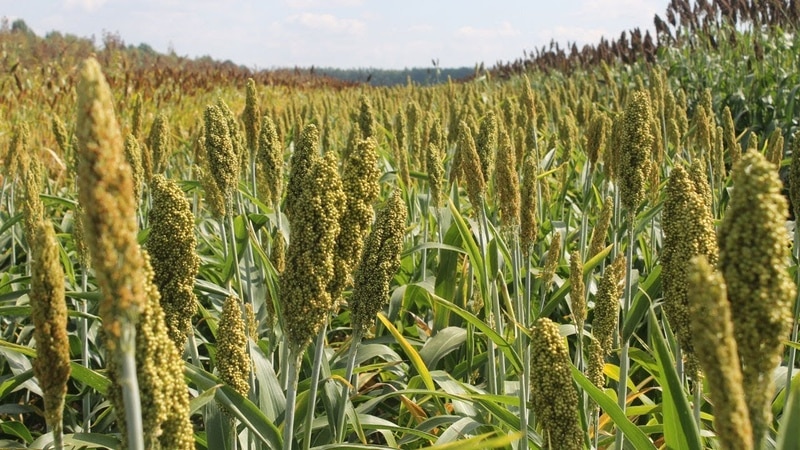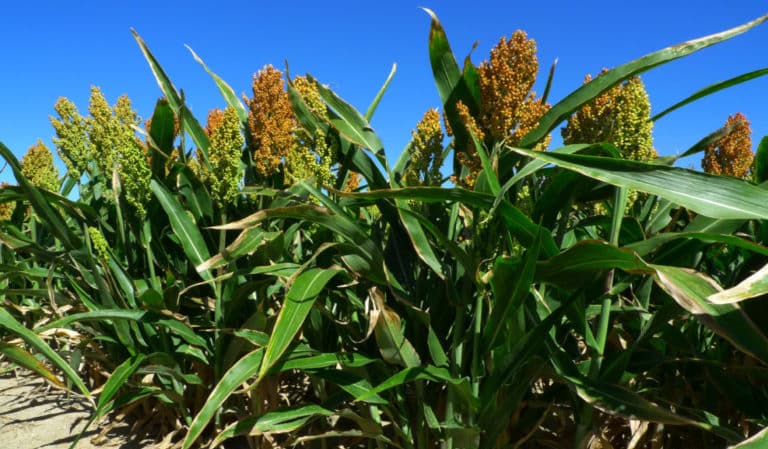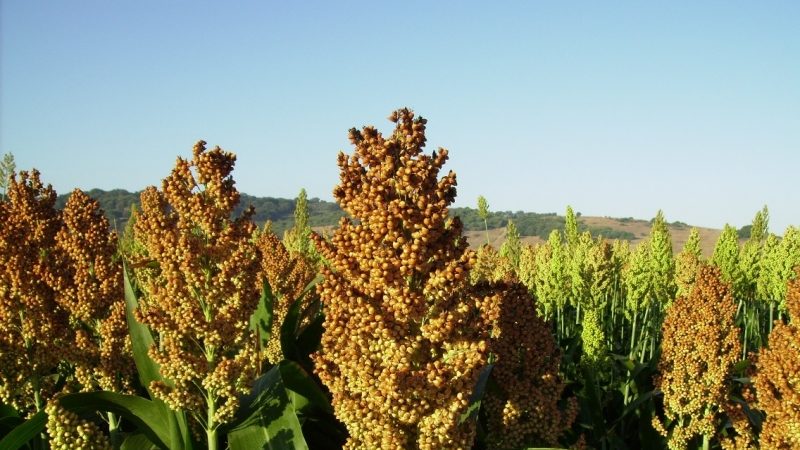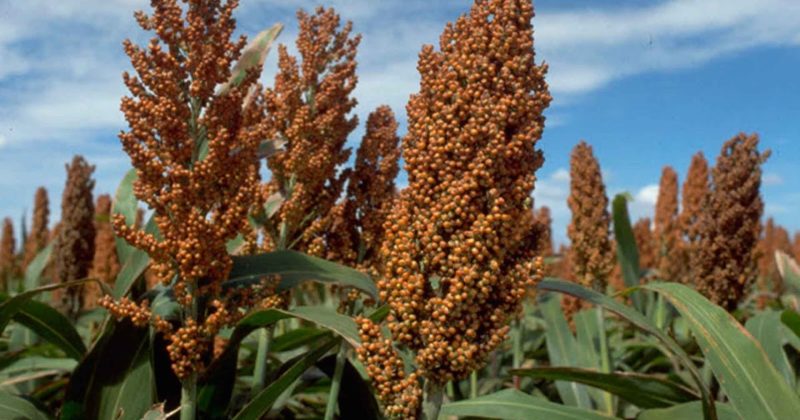What is sweet sorghum, how is it grown and where is it used?
Sorghum is a perennial or annual cereal plant, similar in appearance to corn, which is a spring crop. From an economic point of view, it is divided into 4 types: grain, sugar, broom, herbaceous. Sweet sorghum is a versatile crop used for food, biofuels and animal feed.
What this culture is, how it is used in folk medicine, in everyday life and in cooking, read the article.
What is sweet sorghum
Sugar sorghum - a heat-resistant plant, the stem of which contains up to 20% sugar. This is the only sorghum in nature that synthesizes sucrose in large quantities. By comparison, the sugarcane stalk contains 18–21% sugar.

Botanical description
The sweet sorghum bush reaches a length of 3.5 m. The stems are thick and make up 60% of the mass of the entire plant. The crop is drought-resistant and unpretentious: it grows in places with low rainfall (300 mm per year), in soils with low fertility and high hydrogen content. Productivity is 20–30 tons per hectare.
Types of soil where sweet sorghum produces:
- loamy;
- sandy;
- clayey;
- mixed.
The grains of the plant are covered with a film, slightly open. After flowering begins, sugar begins to accumulate in the plant and reaches its maximum during the period of full ripening.
Anatomical structure of the root and plant
The roots of the sugar variety are fibrous with a thick outer layer of epidermis.The root system of the plant is highly branched in order to extract moisture from the soil during the dry season.
One plant has from 1 to 5 stems, each of which produces 5–25 leaves covered with a waxy coating. Their number depends on the length of the growing season.
Reference! Sorghum seeds are long lasting. At a humidity of 13-14% they remain viable for up to 11 years.
The inflorescences have the shape of a fluffy panicle. The grains are covered with a durable film, like rice. It is preserved after harvest.
Geography of distribution
Sweet sorghum appeared in Northeast Africa about 5 thousand years ago. Distributed in the tropics, subtropics, temperate zone up to 48° latitude.
Largest areas under crops:
- India - 9.5 million hectares;
- Nigeria - 7.1 million hectares;
- Sudan - 4.8 million hectares;
- USA - 3 million hectares.
general characteristics

In the southern and arid regions of the planet, growing beets is either unprofitable or impossible. In these regions it is replaced by sweet sorghum. The cereal crop does not require specific equipment: agricultural machines used for growing corn are suitable for harvesting, cultivating and sowing.
The crop is thermophilic: the minimum temperature for seed germination is +8...+9°C, the optimal temperature is +20...+25°C. At -2...-3°C and below, sorghum dies.
Composition and properties
Vitamin composition of 100 g of sorghum:
- B1 - 0.46 mg;
- B2 - 0.16 mg;
- B4 - 93 mg;
- B5 - 1 mg;
- B6 - 0.4 mg.
Macronutrients:
- potassium - 246 mg;
- calcium - 99 mg;
- silicon - 48 mg;
- phosphorus - 298 mg;
- magnesium - 127 mg.
Microelements:
- aluminum - 1548 mcg;
- boron - 344 mcg;
- iron - 4.41 mg;
- cobalt - 2 mcg;
- copper - 390 mcg.
B vitamins stimulate brain and nervous activity. Phosphorus strengthens bone and muscle tissue, heart and kidneys, and is involved in energy metabolism.Iron ensures the supply of oxygen to cells.
Important! Cereals are not recommended for consumption if there is a disturbance in the intestinal microflora and flatulence.
The nutritional value
100 g of product contains:
- proteins - 10.6 g;
- fats - 4.12 g;
- carbohydrates - 59.6 g;
- kcal - 323.
Benefits for the body
The cereal is useful for rheumatism and for the prevention of diseases of the cardiovascular system.
Medicinal characteristics of sweet sorghum:
- appetite stimulation;
- improvement of metabolism and brain activity;
- acceleration of protein synthesis;
- stabilization of blood sugar levels;
- stimulation of hemoglobin production;
- removing excess salt from the body.
Role in crop rotation
Sweet sorghum is used in bioenergy, feed production, food industry and agriculture. The culture removes heavy metals, harmful salts and toxic elements from fertile soil, thereby exerting a phytomeliorative effect on the soil.
Reference! Sugar production from sorghum is 50% cheaper than from beets.
Usage

Cereal crops are used in many sectors of the world economy: from bioenergy to cooking.
In losing weight
Cereals and honey are made from cereals, which stimulate the natural metabolism in the body due to B vitamins.
Vitamin PP and biotin contained in the cereal break down fats and stimulate the production of amino acids. Therefore, dishes made from sweet sorghum do not lead to the accumulation of fat deposits.
In bioenergy
In bioenergy, the crop is used to produce biological fuel in the form of solid briquettes, biogas and bioethanol.
The latter type is valuable: bioethanol is a renewable energy source that causes less harm to the environment when used in internal combustion engines.
On the farm
Sorghum is made from the stems of any variety brooms, straw and paper. Straw is used to weave furniture and baskets. The plant is useful for livestock farming because its green parts are used for feed or hay. With the right harvesting technology, 1 hectare of crop yields up to 5 tons of organic matter, which nourishes the soil with useful elements.
In cooking
Molasses is extracted from the crop, which is used in food preservation and the production of alcoholic beverages, and flour is made.
Prepared from sweet sorghum:
- jam and marmalade;
- syrup;
- alcohol.
Growing
The cereal crop is unpretentious in care. For a bountiful harvest, sorghum requires optimal temperature, watering and fertilizer. Ideal for growing sorghum plot should be well warmed up and illuminated by the sun.
Preparation of soil and planting material
The seeds of the plant are poured with water for half an hour. The floating specimens are removed. After soaking, the planting material is thoroughly dried: laid out on parchment or fabric in one layer and placed in a dry, ventilated place.
Almost any soil is suitable for seeds. Before sowing, the soil is loosened and watered moderately. Urea and humus are used as fertilizers.
Sowing technology
When the outside temperature rises above +8°C, seeds are planted in the soil. As a rule, this happens in early May. The crop is planted in rows to a depth of about 5 cm. The distance between plants is 10 cm.
Further care
After 2 weeks, the first shoots appear. At this stage, weak plants are separated from healthy and strong ones. During the growing season, regular weeding is carried out to remove weeds and the soil is loosened.
As a top dressing, add 5–7 g of nitrogen, 15 g of phosphorus and potassium per 1 m2.
Advice! Double hilling in the second half of summer increases productivity.
Watering is carried out once every 1-2 weeks.

Disease and pest control
Sorghum is considered resistant to pests plant, but some insects are able to destroy plantings:
- Cereal aphid. To combat it, plants are sprayed with Metaphos. The first treatment is carried out when aphids appear, the second after 10–12 days. The biological control method is the aphid beetle, which is released onto the crops. The insect gradually destroys the aphids, while leaving the sorghum untouched.
- Scoops. Trichogramma vulgaris is used as a biological weapon. She lays her eggs in the eggs of pests, thereby stopping their life cycle and mass spread. Chemical sprayers used include Metaphos and Chlorophos.
- Wireworms. These pests feed on sprouted seeds, which reduces the quality and quantity of the crop. To combat wireworms, ammonia water is used, which is added to the soil, and Fentiuram.
Serious damage to the crop is caused by leaf diseases and grain fusarium. Fusarium grain contains mycotoxins and is unsuitable for use. To reduce infection, TMTD seeds are treated 6 months before sowing (2 kg per 1 ton).
In case of leaf spotting, seeds are cleaned and sorted from diseased ones and phosphorus-potassium fertilizers are applied.
Harvesting, storage and processing
On an industrial scale, sorghum is harvested using combines, specialized sorghum harvesting machines, or manually. The crop is harvested by mowing even before the panicles are fully formed. Otherwise, the greens will become stale.
Harvesting occurs at the end of July or beginning of August, when the grains enter the wax phase.The greens are used for agricultural feed and silage.
Important! At the beginning of harvest, unripe seeds are wet, so they are placed in a dryer.
Plants are either broom dried or processed into products. Store prepared raw materials in a dry, ventilated area for 2 years, sorghum flour for a year.
Conclusion
Sweet sorghum is becoming more and more popular every year due to its drought resistance, high yield and low cost of production. The plant is unpretentious, but in terms of sucrose production it is ahead of corn and sugar beets. The cereal crop is most widely used in agriculture: it is used to make feed, hay and silage.